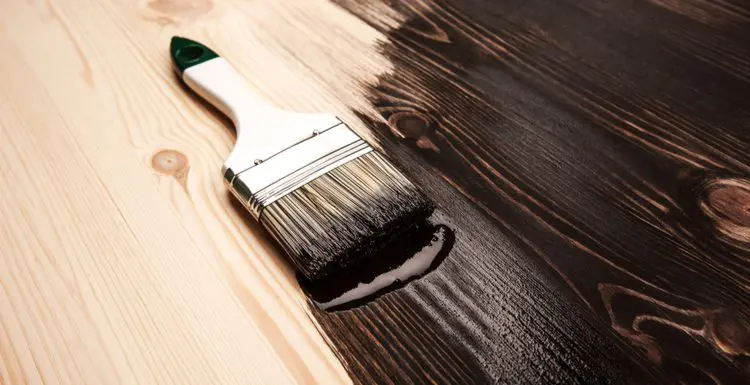Can you paint over stains? And if so, what are the steps to do it?
Don’t worry; we’ll cover answers to these questions and much more in our guide. Read on to learn all you need to know.
Can You Paint Over Stain?
Home improvement projects are some of the most rewarding ways to spend your time. Painting wood is a beautiful way to breathe some new life into a tired look.
Whether you’re doing a complete remodel of your home or just updating an old piece of furniture, the key to success is to be careful and do it right.
The Short Answer:
We have good news: yes, you can paint over stains!
That being said, to protect the wood surface underneath and the value of the item you’re painting, you have to go about it properly.
In this article, we’ll walk you through what you need to do, step-by-step, to successfully paint over a wood stain.
What Is Wood Stain?
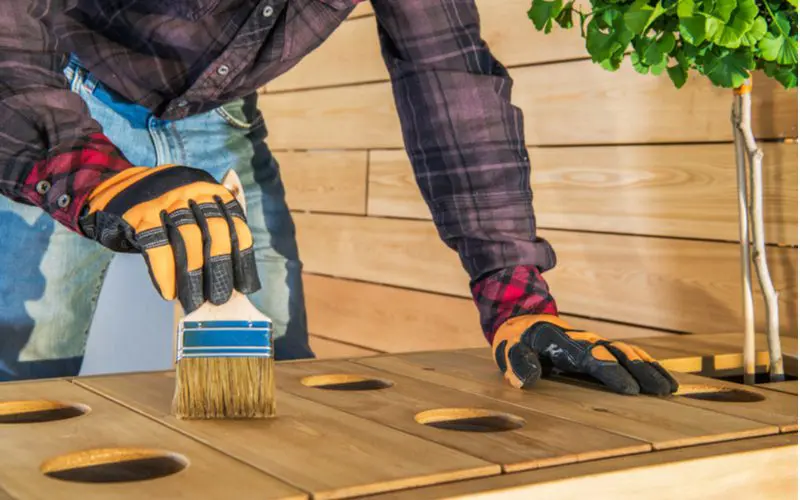
Virrage Images/Shutterstock
Wood stain is a type of paint made from the same three primary ingredients as paint, so it’s very similar in some ways. The critical difference between the two is that paint does not get absorbed into the material that it’s applied to, while stain does.
Wood stain is manufactured explicitly to penetrate the surface of the wood to protect it against weather elements, water, wear and tear, and more. In terms of color, it usually tints wood rather than completely coloring it.
The chances are excellent that all of the wood furniture and other fixtures in your home are stained. Luckily, you can paint over the stain. Let’s look at the first steps to doing so.
How to Paint Over Stain
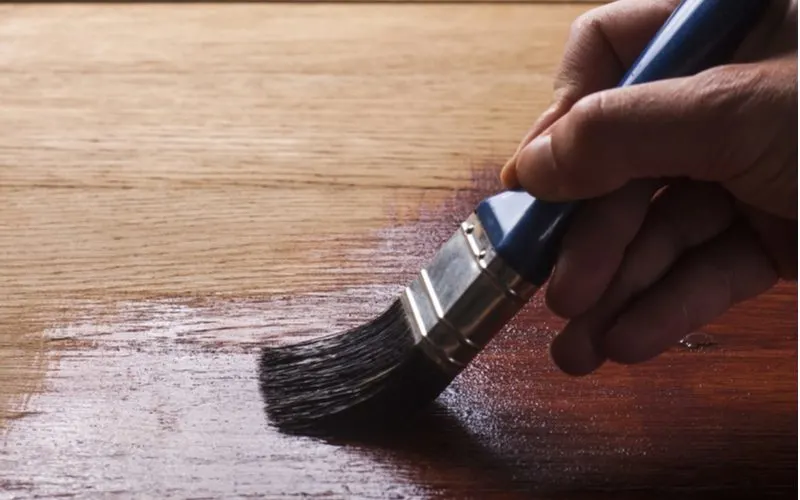
Carlos Andre Santos/Shutterstock
While you can apply paint over stain, you can’t simply start painting without any preparation. Wood is a beautiful material, but it’s also delicate and must be treated with care.
1. Sand the Surface
The first thing you must do to paint over stain is sand down the wood surface, especially if it’s shiny or glossy. Use 150-grit sandpaper or finer for this job.
Sanding the surface removes that excess layer, which means that the paint will adhere better. In addition, sanding guarantees an even surface, so the paint will absorb better and look the same across the entire piece.
2. Brush off the Debris
If you choose not to sand the surface, then the tannins from the stain may show through the paint. Once you’ve finished sanding, you’ll have a layer of dust and debris.
Brush it off, and then use a thin layer of deglosser or liquid sandpaper on the entire surface. Be sure to wear gloves and other protective gear.
3. Fill Any Holes
Once the liquid sandpaper is dry, you should fill in any holes and dings with wood filler. Otherwise, these damages will show even after the wood is painted.
Repeat the sanding to smooth them in line with the rest of the wood, and then use a slightly damp rag to clean any debris or dust off the surface.
4. Prime and Paint the Surface
Finally, we recommend doing a layer of quick-dry primer before beginning the actual painting process. It’s optional, of course, but it will make your job a lot simpler once you get going.
It’s worth mentioning that you’ll use most of the same steps with unstained wood as well. You still need to sand and prepare the wood before painting.
How to Paint on Top of Stain
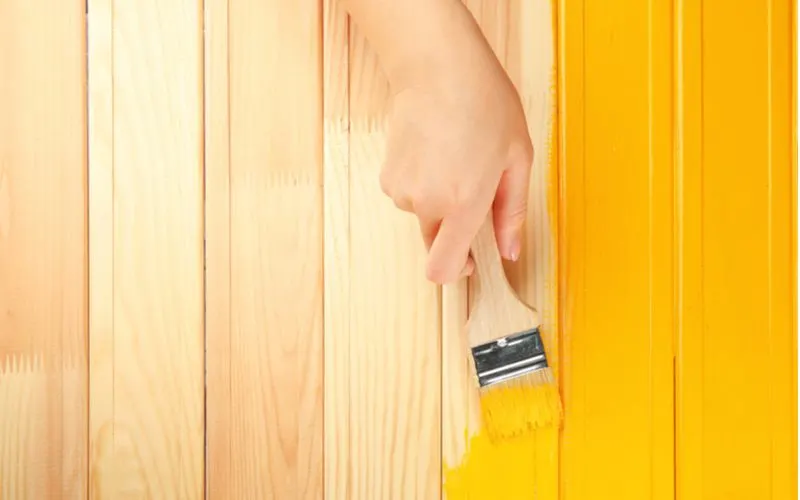
Africa Studio/Shutterstock
Now that you know how to get your wood surface ready to paint, it’s time to get started.
1. Gather Your Materials
First, you need to buy the correct type of paint. Wood is a very common surface for painting, so it shouldn’t be hard to tell if the colors you want come in a formula appropriate for wood.
It should say so right on the packaging. Generally speaking, water-based latex paint is the best type to use.
Even if you used the quick-dry primer already, you would still need to use a water-based latex primer before applying the paint.
The primer helps the paint adhere evenly and look its best. It will help bring out the paint’s actual color and prevent the wood underneath from discoloring the paint.
2. Prime the Surface
Primer also extends the time needed between coats of paint.
You only need a single coat of primer, but be sure to allow it to dry completely before beginning the paint (the quick-dry primer will help speed that up a lot).
3. Paint the Wood
When you begin to paint, be sure to use a high-quality brush. Otherwise, tiny bristles may break off and stick to the finished product.
Apply a single thin coat, making sure to get into all of the corners and crevices. Brush the paint on in the direction of the grain of the wood.
4. Apply a Second and Third Coat
Allow the first coat to dry completely. We recommend applying a second coat, even if it doesn’t look as though it needs it.
Over time, the paint will fade. In addition, if the wood gets dinged, an extra layer helps prevent the wood underneath from making an appearance.
After the second coat of paint has dried, assess whether a third is needed. It won’t be most of the time, but if the wood or stain underneath is very dark, it could.
Always wait until the previous coat is completely dry before applying another. To be safe, we recommend leaving it overnight.
As long as you used water-based latex paint, you don’t need a top coat. The paint and primer themselves should offer the sealant that you need to protect the wood. However, leave it to dry for at least 24 hours before using the wood for anything else.
Finally, be sure to keep a record of the kind of paint you used. Write down the brand, color, and color number. That way, if you ever need another can, you don’t have to play a risky guessing game.
Caring for Painted Wood
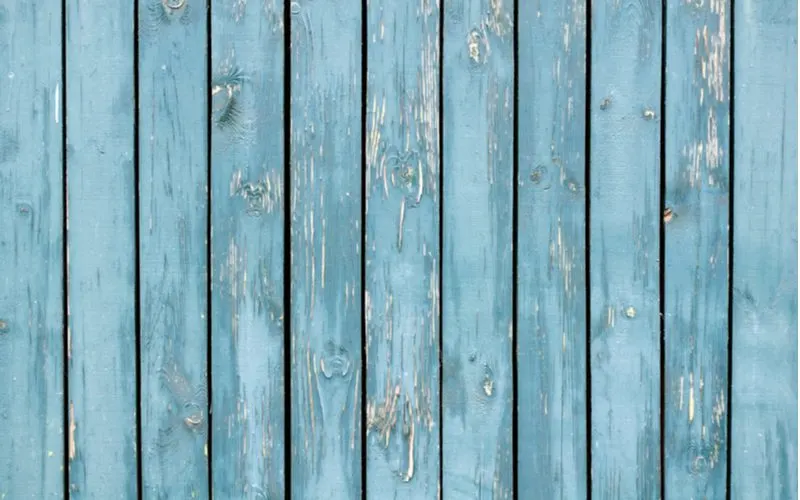
Imageman/Shutterstock
Lucky for you, caring for painted wood is relatively simple. Let’s look at how.
Even though the wood has been painted and the paint provides a sealant, you still want to avoid getting it too wet.
A little bit of moisture is okay, though. Just don’t let it pool or sit. In addition, place a layer underneath anything hot that you put on the wood (for instance, if you painted a dining room table).
If you need to clean the wood surface, try using just a dry or damp dusting cloth to clean the mess. You can also use furniture polish or wood furniture cleaner if the rag doesn’t do the trick.
We don’t recommend using any other chemicals or disinfectants on a wood surface, even once painted. If you’re concerned about germs on a table, for instance, use placemats or a tablecloth. You can also use disinfectant UV lights on wood.
As we said above, depending on how much wear and tear your wood surface gets, you may need to repeat the process and re-paint every several years. The good news is that you’ll already have all of the materials you need; best of all, you know what you’re doing.
Painting wood, whether it be part of the structure of your home (such as trim or a banister) or a piece of furniture, is a great way to extend its life and modernize it. Luckily, as we’ve seen, it’s a simple process that virtually anyone can tackle.

